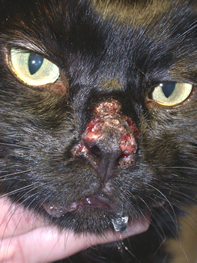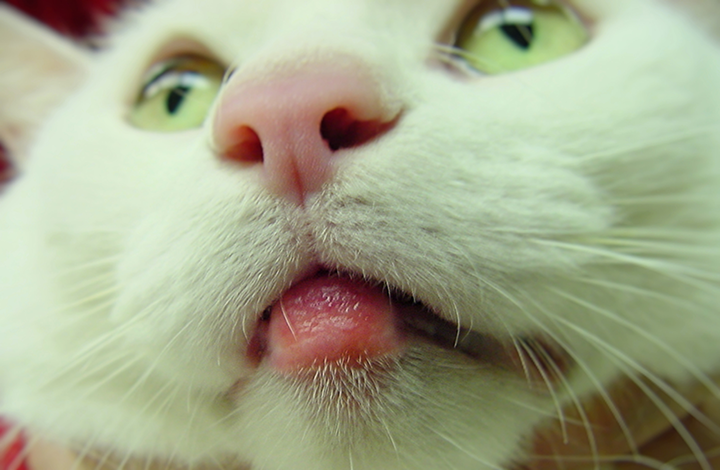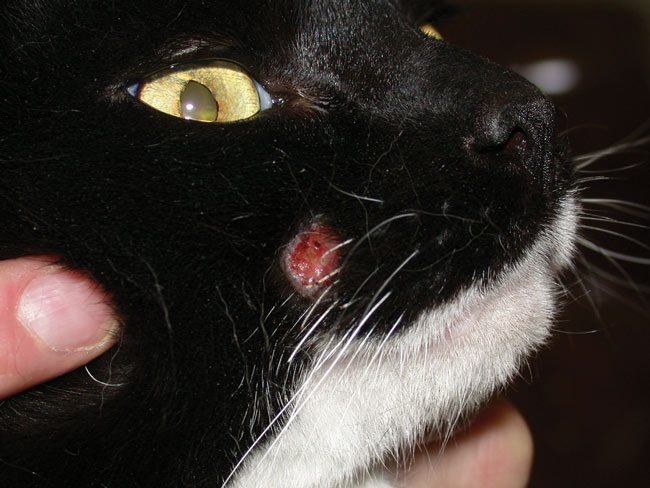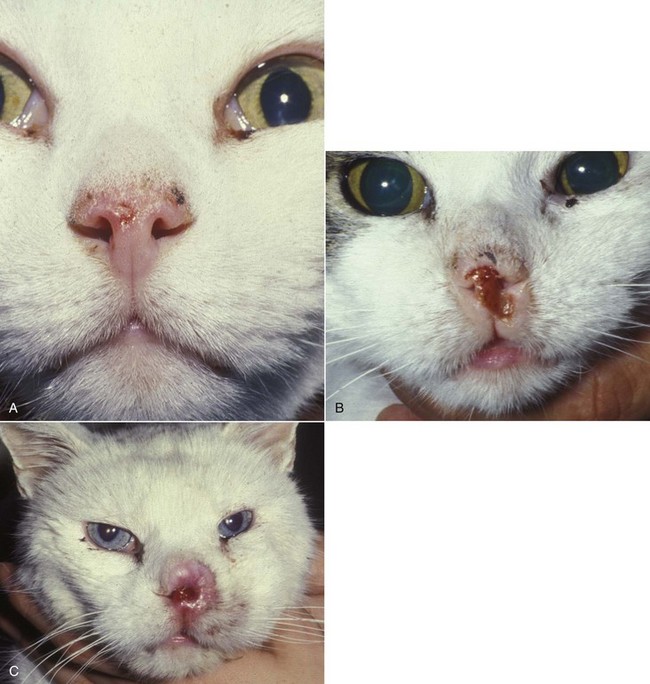eosinophilic granuloma cat nose
Though the eosinophil is typically associated with parasitic or environmental antigenic exposure it can be associated with other causes. Grossly lesions may appear as raised linear bands of yellow to erythematous tissue along the posterior legs or as papules and.

Dermatology Clinic For Animals Feline Herpes Virus Dermatitis In Tacoma Wa Dermatology Clinic For Animals
Eosinophilic granuloma complex with weight loss and breathing problems in Maine Coon Cat Question.
. These inflammatory skin problems can be caused by a number of underlying conditions but most likely are the result of an allergic disorder. Eosinophilic granulomas are raised circular yellowish to pink nodules. Eosinophilic granulomas can occur anywhere but most appear in the mouth hind legs and.
Eosinophilic ulcers are part of a disease group termed eosinophilic granuloma complex EGC. Eosinophilic granuloma complex EGC is a syndrome occurring in cats characterized by lesions affecting the skin and the oral cavity. Swollen lips in cats are usually caused by a condition called eosinophilic granuloma complex.
You cant rule out other reasons such as allergic reactions feline acne injuries or even dental problems. Plaques can coalesce to affect a large raised moist area. Because of this phenomenon a cats nose can swell greatly skin redden and even bleeding ulcers may occur.
Feline allergic skin disease can take some highly ulcerative forms especially involving the upper lip. EOSINOPHILIC PLAQUES A plaque is defined by its shape. It is extremely itchy and cats will scratch and rub the affected sites.
They may be found anywhere on the body but are. Eosinophilic granulomas the most variable-appearing lesion of the eosinophilic granuloma complex EGC may be round to oval to linear and can occur as papules nodules or plaques. Usually there is some kind of allergy that causes an eosinophilic granuloma.
Eosinophilic granulomas may be found in each cats at any age but always proceed in different way. Different clinical forms of the disease are recognised although the underlying inflammatory response often appears very similar. Corticosteroids are available in different forms that have different durations of activity.
A subset of this disease has been associated with mosquito bites 4 and. Genetically initiated eosinophilic granuloma is generally seen in cats that are younger than two years of age. The eosinophilic granuloma complex EGC in the cat actually consists of three similar diseases.
If nasty raised lesions start forming on your cat he might be suffering from inflammatory granulomas. 10 yr old indoor white with black Maine Coon has scabs on the bridge of his nose and around the edge of his nose that will not heal. Eosinophilic granulomas are raised circular yellowish to pink nodules.
Formally known as eosinophilic granuloma complex in cats they consist of ulcers and plaques as well as granulomas. The eosinophilic plaque has been associated with the underlying diseases of food allergy flea allergy and atopy. Corticosteroids are the most common treatment to control the symptoms of eosinophilic granuloma complex.
Despite the name the three diseases do not always cause granulomas. The presence of eosinophilic degranulation products have been documented coating but not altering the collagen in all of these diseases. In cats females may be more likely to develop one or more of the syndromes of eosinophilic granuloma complex than are males.
Eosinophilic plaque manifests as inflamed hive-like bumps on the inner thighs and abdomen. They may be found anywhere on the body but are most common on the head face bridge of the nose ears paw pads lips chin mouth and thighs. Eosinophilic granuloma is by far the most common of the three conditions in cats.
Eosinophilic plaque a well-defined red raised wound is most commonly found on the belly and thighs. Fleas are the number one cause- and yes even a single flea can be problematic so stringent flea control should be followed. What is eosinophilic granuloma cat lip.
These diseases are best thought of as inflammatory reactions of the. To handle feline eosinophilic granuloma complex start by taking your cat to the vet for a proper diagnosis and treatment plan. Think of a flat-topped butte protruding from the landscape in Montana miniaturize it to 2 mm by 20 mm put that on your cat and you have a plaque.
Eosinophilic microvesicles and microabscesses may be seen in the epidermis. Then follow their recommendations which may include giving your cat antibiotics or corticosteroids or scheduling it. Eosinophilic ulcers usually present inside the mouth or on the top lip.
Eosinophilic Granuloma Complex in Cats - Veterinary Partner - VIN. Most of the time Kittys experiencing an allergic reaction when these sores show up. What are eosinophilic ulcers in cats.
Eosinophilic Granuloma Complex is a hard condition to explain especially since it has several forms but we will give it a try. Eosinophilic Granuloma Complex Cats respond to a variety of antigenic stimuli with infiltration of a particular cell of the body known as an eosinophil. Conventional treatment is mainly symptomatic and may have undesirable side effectsThis paper summarizes homeo-pathic treatment with snake remedies of cats suffering from EGC.
Feline Eosinophilic Granuloma occurs most commonly in the oral cavity or in a linear fashion on the back legs. These lesions are often infected with bacteria which usually make this condition worse. Eosinophilic granuloma occurs in dogs and young cats in response to a hypersensitivity reaction similar to plaque formation.
They may appear as non-ulcerated swelling on the chin lower lip nose or around the footpads fat lip fat nose fat chin syndromes. Linear lesions are found most often on the thighs but have been seen on other body. This cat has an erythematous eroded swollen nodule on the chin.
The eosinophilic granuloma was formerly termed collagenolytic due to the histopathologic appearance of the brightly eosinophilic collagen flame figures but recent evidence suggests that the collagen itself is not degenerated. Most often cats are treated with corticosteroid injections eg long acting corticosteroids brand name Depomedrol or tablets eg prednisolone. Atopy or allergies to pollens house dust mites or other types of environmental alle.
Remedies and treatment options will depend on the root cause. It appears that EGC is a form of reaction pattern seen in the skin of cats that may potentially be initiated by a number of. Allergic disorders usually develop after a cat has reached the age of two.
The term eosinophilic granuloma complex EGC refers to a group of inflammatory skin problems in cats. Lesions may erode or ulcerate and can develop necrotic foci.
Black Spot On My Cat S Nose I Don T Know What It Is Thecatsite

Egc Lesions In Cats Brief Media

Distinguishing Between Dermatologic Disorders Of The Face Nasal Planum And Ears Veterinary Clinics Small Animal Practice

Rodent Ulcers Aka Indolent Ulcers In Cats Tails Tips

Dermatology Clinic For Animals Mosquito Bite Hypersensitivity In Tacoma Wa Dermatology Clinic For Animals

Figure 9 From Feline Eosinophilic Granuloma Complex Ities Semantic Scholar

Small Animal Allergies Commonly Presenting Conditions Vet Times

Egc Lesions In Cats Brief Media

Tumors Of The Respiratory System Veterian Key

Severe Eosinophilic Granuloma Complex Rodent Ulcer Flickr
Eosinophilic Granuloma Complex In Dogs And Cats Greenside Animal Hospital Greenside Animal Hospital

Egc Lesions In Cats Brief Media

Plaques Nodules And Eosinophilic Granuloma Complex Lesions Springerlink

What Are Those Painful Looking Red Sores On My Cat S Lips Or Body Egc

Nasal Squamous Cell Carcinoma In Cats Veterinary Partner Vin


